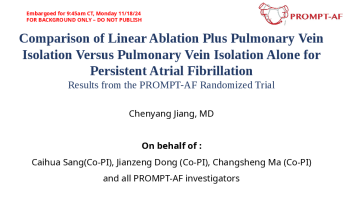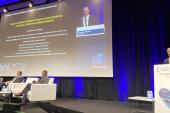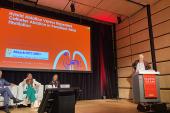Two Trials Provide Insights Into Catheter Ablation Options for Persistent AF
There remains a need to identify patients who will derive benefits from adjunctive techniques on top of pulmonary vein isolation.

For patients undergoing catheter ablation for persistent atrial fibrillation (AF), cryoballoon and radiofrequency catheters are both effective in achieving pulmonary vein isolation (PVI). And the addition of linear ablation plus alcohol ablation of the vein of Marshall also may have some benefits over PVI alone, new data show.
The CRRF-PeAF and PROMPT-AF trials, presented Monday at the American Heart Association 2024 Scientific Sessions in Chicago, IL, provide information for clinicians who continue to search for ways to improve upon the suboptimal results of PVI alone in patients with persistent AF.
The two trials are complementary, commented Jason Andrade, MD (Vancouver General Hospital, Canada), who served as the discussant for CRRF-PeAF. “They’re steps forward. They’re helpful in improving our knowledge of the treatment of persistent A-fib, which is definitely an area where we need to improve our knowledge,” he told TCTMD.
“I don’t know that either trial necessarily [provided] a compelling or game-changing result, but on the whole, they provide help to clinicians,” he continued. They suggest that “whichever technology you want to use is probably reasonable if PVI is your goal, and that vein of Marshall ablation has a role—it hasn’t completely fallen by the wayside like some of the other adjuncts. We just need to refine a little bit who’s going to get the biggest benefits without conferring a harm of the additional ablation.”
There’s also a message for the use of catheter ablation in persistent AF more broadly, Andrade indicated, because a major issue in the field is the lack of a mechanistic understanding of persistent AF, in which there may be multiple underlying factors at play. The efficacy of various adjuncts to PVI likely varies based on the specific issues causing a patient’s persistent AF.
“In the trials, without being able to identify which mechanism dominates in any patient, we probably see regression to the mean, and the results all come back to [these additional approaches are] not on average better than PVI,” he said. “I think that’s the biggest issue that we have—personalizing our treatments for persistent atrial fibrillation to know who should have a posterior wall isolation or who should have a vein of Marshall ablation with alcohol or who should have linear ablation. I think that’s where the biggest bang for the buck is going to be moving forward.”
Cryoballoon vs Radiofrequency Ablation
Prior to the relatively recent emergence of pulsed-field ablation (PFA), cryoballoon and radiofrequency catheters were the two primary methods for delivering catheter ablation in patients with AF. Multiple studies, including the FIRE AND ICE trial, have shown that both energy sources provide similar results when used for PVI, the cornerstone of AF ablation.
But data from other trials, such as CIRCA-DOSE and NO-PERSAF, suggest that the patterns of AF recurrence may differ between cryoballoon and radiofrequency ablation, perhaps related to differences in reverse remodeling by energy source, according to Kengo Kusano, MD, PhD (National Cerebral and Cardiovascular Center, Suita, Japan), who presented the CRRF-PeAF results at the AHA meeting.
To better evaluate potential differences between cryoballoon and radiofrequency ablation, Kusano and his colleagues performed CRRF-PeAF at 12 centers in Japan. They randomized 500 patients with persistent AF (mean age 69 years; 73% men) to one of the two ablation modalities then followed them for 1 year. After a 90-day blanking period, ECGs were recorded twice daily through 1 year, with 24-hour Holter monitoring conducted at 3 and 12 months.
PVI was successful in all cases. Compared with radiofrequency ablation, procedures done with a cryoballoon had a shorter total procedure time (median 93 vs 137 min) and longer fluoroscopy time (median 18.4 vs 11.0 min; P < 0.001 for both).
Adjunctive ablation techniques on top of PVI were common in both groups (35.7% with the cryoballoon and 40.0% with radiofrequency). Patients who underwent radiofrequency ablation were more likely to receive cavotricuspid isthmus ablation (22.8% vs 13.7%), superior vena cava isolation (10.4% vs 4.8%), and left atrial posterior wall isolation (15.6% vs 8.0%), but less likely to get left atrial roof line ablation (2.0% vs 18.9%), compared with those treated with the cryoballoon.
Rates of complications were low in both the cryoballoon and radiofrequency groups (2.0% vs 3.6%; P = 0.42).
The primary endpoint was the occurrence of atrial tachyarrhythmias at 1 year (excluding the 90-day blanking period after ablation), assessed for the noninferiority of cryoballoon ablation. The rate was 22.5% in the cryoballoon arm and 23.2% in the radiofrequency arm (HR 0.99; 95% CI 0.69-1.43). Because the upper limit of the confidence interval was below 1.5, cryoballoon ablation was considered noninferior to radiofrequency ablation.
There were no differences across various secondary endpoints, including AF recurrence, atrial tachycardia recurrence, atrial flutter recurrence, AF burden, cardiovascular events, or all-cause death.
However, radiofrequency ablation was associated with significantly greater reverse remodeling of the left atrium compared with cryoablation, with a greater reduction in left atrial volume index through 1 year (-11 vs -4 mL/m2; P < 0.001). That could be related to a greater increase in left atrial stiffness after radiofrequency versus cryoballoon ablation, Kusano speculated.
In the past, many operators would hesitate to use cryoablation for PVI for persistent AF because “it was felt to be less malleable as a technique and more of a kind of one-size-fits-all,” Andrade explained.
So this trial “had the potential to be very informative in the sense that, if the results were similar, which they were, it would suggest that you could do either cryo or RF as your procedure to do PVI for patients with persistent A-fib,” he said.
CRRF-PeAF was limited, however, in that 35-40% of patients also had adjunctive ablations performed. “And so it lost a little bit of its potentially informative nature there,” Andrade said, “but at least conceptually, they showed that cryo-based procedures versus RF-based procedures gave you very similar outcomes for persistent A-fib.”
There are also mechanistic insights to be gleaned from the trial, he suggested, noting that in CIRCA-DOSE, which he led, there was a lower rate of progression to persistent AF with radiofrequency versus cryoballoon ablation. The greater reverse remodeling seen with radiofrequency in CRRF-PeAF “may explain part of that,” Andrade said. “Potentially by getting more reverse remodeling, you might see less problems down the road with RF compared to cryo.”
Overall, though, “both options are good,” he said. “If your perspective is we’re doing PVI, then you should do it with the tool that gives you the most consistent result for PVI.”
Alcohol Ablation of the Vein of Marshall
The results of PROMPT-AF, published simultaneously online in JAMA, were presented by Chenyang Jiang, MD (Sir Run Run Shaw Hospital, Hangzhou, China), who noted that the addition of linear ablation has failed to improve on PVI alone in prior randomized trials.
Other adjunctive techniques have been tried to boost the results of PVI in patients with persistent AF, including ethanol infusion of the vein of Marshall (EIVOM). The VENUS trial indicated a potential benefit of this approach.
In PROMPT-AF, conducted at 12 tertiary centers in China, the investigators examined whether adding linear ablation using radiofrequency energy (including mitral isthmus, left atrial roof, and cavotricuspid isthmus ablation) combined with EIVOM could improve the efficacy of PVI alone.
The main analysis included 498 patients (mean age 61.1 years; 72.9% men) who had drug-refractory AF lasting more than 3 months and were undergoing a first-time ablation. They were monitored with wearable single-lead ECG patches, with supplemental symptom-triggered ECGs and Holter monitoring. The average monitoring time was about 13 hours per week in both groups.
Adding linear ablation plus EIVOM resulted in longer procedures (mean 188 vs 141 min) with more fluoroscopy time (mean 16 vs 5 min; P < 0.001 for both). There were also numerically more complications compared with PVI alone, driven by a greater number of cases of pericarditis or pericardial effusion not requiring draining (seven vs zero).
The added ablations, however, provided an advantage for the primary endpoint, which was freedom from any documented atrial arrhythmias lasting more than 30 seconds, without use of antiarrhythmic drugs, through 12 months (70.7% vs 61.5% with PVI alone). The hazard ratio showed a lower risk in the patients who received linear ablation plus EIVOM (HR 0.73; 95% CI 0.54-0.99)
There were no differences between trial arms for any of the secondary outcomes, including AF burden and quality of life.
Though adding linear ablation plus EIVOM reduced arrhythmia recurrence over PVI alone, that came at the cost of longer procedures with more complications, Andrade stressed. “Is adding alcohol ablation to the vein of Marshall worth the added trouble that comes along with doing it, especially as we move as a field to novel technologies and techniques like PFA?” he asked.
Probably not, Andrade said, citing procedure duration, complications, and the lack of a difference in AF burden between the groups. “By doing all this, you might stop an episode of flutter or an episode of atrial tachycardia,” he said, “but it doesn’t in the big picture seem to make much difference in the overall amount of time that patients are spending in atrial fibrillation.”
Todd Neale is the Associate News Editor for TCTMD and a Senior Medical Journalist. He got his start in journalism at …
Read Full BioSources
Sang C, Liu Q, Lai Y, et al. Pulmonary vein isolation with optimized linear ablation vs pulmonary vein isolation alone for persistent AF: the PROMPT-AF randomized clinical trial. JAMA. 2024;Epub ahead of print.
Kusano K. Cryoballoon ablation versus radiofrequency ablation in patients with persistent atrial fibrillation (CRRF-PeAF): a prospective, multicenter, randomized, noninferiority clinical trial. Presented at: AHA 2024. November 18, 2024. Chicago, IL.
Disclosures
- PROMPT-AF was supported by a grant from the National Key Research and Development Program of China and the Beijing Xinlian Zhicheng Cardiovascular Health Public Welfare Foundation.
- Jiang reports honoraria or lecture fees from Johnson & Johnson, Abbott, Boston Scientific, and Bayer.
- Kusano reports receiving funding/grants from Boston Scientific and Medtronic.
- Andrade reports receiving consulting fees/honoraria from Biosense Webster, Boston Scientific, and Medtronic; and having received research grants from the Canadian Arrhythmia Network, a Network of Clinical Excellence, the Heart and Stroke Foundation of Canada, and the Michael Smith Foundation for Health Research.






Comments